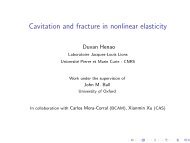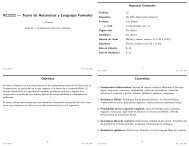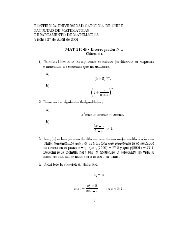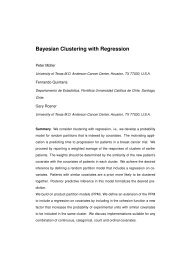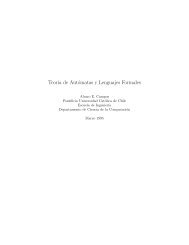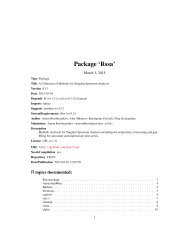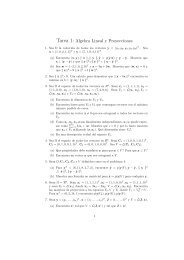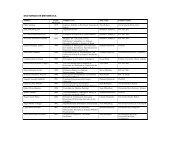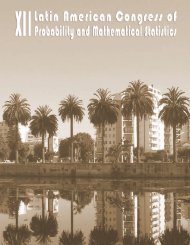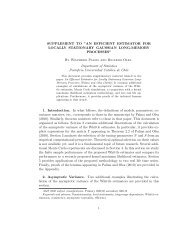Introducción a la Lógica Algebraica ∗ - Facultad de Matemáticas ...
Introducción a la Lógica Algebraica ∗ - Facultad de Matemáticas ...
Introducción a la Lógica Algebraica ∗ - Facultad de Matemáticas ...
You also want an ePaper? Increase the reach of your titles
YUMPU automatically turns print PDFs into web optimized ePapers that Google loves.
2. El lenguaje <strong>de</strong> <strong>la</strong>s lógicas modales agrega al anterior un conectivo unario<br />
✷, l<strong>la</strong>mado operador <strong>de</strong> necesitación <strong>de</strong> tal modo que si ϕ es una fórmu<strong>la</strong>,<br />
✷ϕ también lo es.<br />
Una función σ : P −→ FmL se pue<strong>de</strong> exten<strong>de</strong>r recursivamente <strong>de</strong> manera<br />
única a <strong>la</strong> función ¯σ : FmL −→ FmL como sigue:<br />
¯σ(ϕ(p1, . . . , pn)) = ϕ(σ(p1), . . . , σ(pn)) .<br />
Dicha función <strong>la</strong> l<strong>la</strong>maremos substitución y <strong>la</strong> <strong>de</strong>notaremos por <strong>la</strong> misma<br />
letra σ. Para cada Γ ⊆ FmL <strong>de</strong>notaremos σ(Γ) al conjunto <strong>de</strong> fórmu<strong>la</strong>s<br />
σ(Γ) = {σ(ϕ) : ϕ ∈ Γ}.<br />
Una reg<strong>la</strong> <strong>de</strong> inferencia sobre CL es un par 〈Γ, ϕ〉, don<strong>de</strong> Γ ⊆ FmL, Γ es<br />
finito y ϕ ∈ FmL .<br />
Diremos que ψ es directamente <strong>de</strong>mostrable a partir <strong>de</strong> ∆ por <strong>la</strong> reg<strong>la</strong> 〈Γ, ϕ〉,<br />
si existe una substitución σ tal que σ(ϕ) = ψ y σ(Γ) ⊆ ∆.<br />
Un axioma es una reg<strong>la</strong> <strong>de</strong> <strong>la</strong> forma 〈∅, ψ〉. Cualquier sustitución <strong>de</strong> un axioma<br />
es directamente <strong>de</strong>mostrable a partir <strong>de</strong> cualquier conjunto <strong>de</strong> fórmu<strong>la</strong>s<br />
∆. Cada sustitución será una instancia <strong>de</strong>l axioma. Una formu<strong>la</strong> tal que<br />
∅ ⊢S ϕ es un teorema <strong>de</strong> S y lo <strong>de</strong>notamos simplemente ⊢S ϕ<br />
Un sistema <strong>de</strong>ductivo S sobre L, está <strong>de</strong>terminado por un conjunto <strong>de</strong> axiomas<br />
y <strong>de</strong> reg<strong>la</strong>s <strong>de</strong> inferencia. Enten<strong>de</strong>remos a S como un par 〈L, ⊢S 〉<br />
don<strong>de</strong> ⊢S es una re<strong>la</strong>ción entre conjuntos <strong>de</strong> fórmu<strong>la</strong>s y fórmu<strong>la</strong>s <strong>de</strong>finida<br />
<strong>de</strong> <strong>la</strong> manera siguiente:<br />
∆ ⊢S ψ si y sólo si existe una sucesión finita 〈ϕ1, ϕ2, . . . ϕn〉 <strong>de</strong> fórmu<strong>la</strong>s <strong>de</strong><br />
FmL, tal que ϕn = ψ y para todo i ≤ n, se cumple alguna <strong>de</strong> <strong>la</strong>s condiciones<br />
siguientes:<br />
• ϕi es una instancia <strong>de</strong> un axioma.<br />
• ϕi ∈ ∆<br />
• para ciertos i1, i2, . . . , ik todos menores que i, ϕi es directamente <strong>de</strong>mostrable<br />
a partir <strong>de</strong> {ϕi1, . . . , ϕik }.<br />
11



